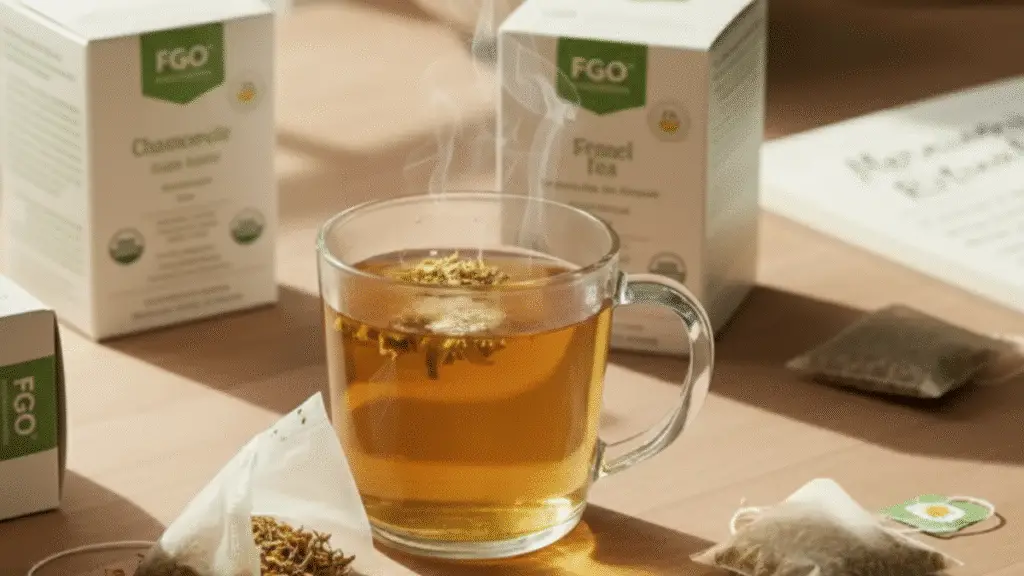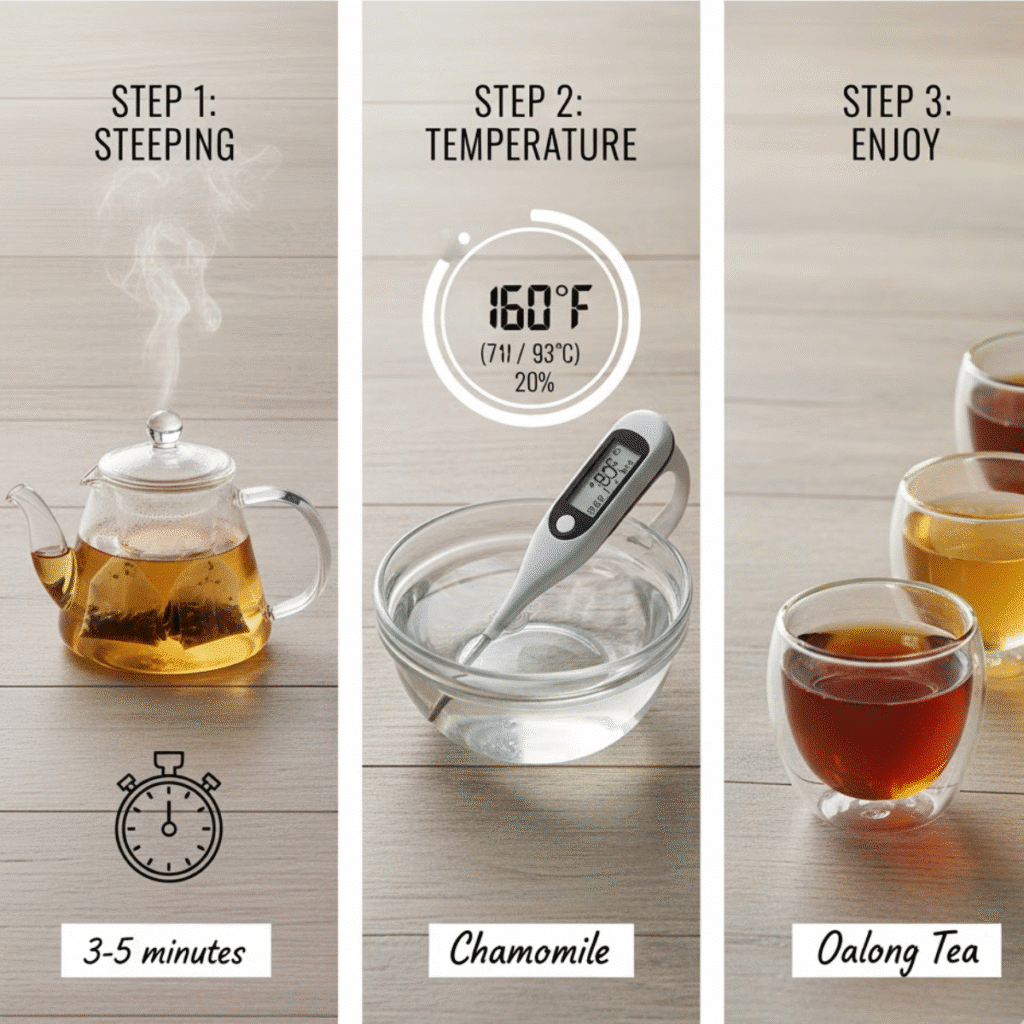
You’ve probably seen the headlines—”Is green tea the new Ozempic?” Look, I get it. We’re all searching for that magic bullet for wellness and weight management. But here’s the thing: while FGO tea won’t replace your doctor’s prescription, it absolutely deserves a place in your holistic wellness routine for reasons that actually hold up under scientific scrutiny.
I’ve been exploring tea varieties for years now, and what keeps bringing me back to FGO organic tea isn’t just the taste (though that’s fantastic). It’s the transparent quality, the organic certification, and the fact that when you’re sipping a cup of their green tea, you’re actually getting meaningful amounts of the compounds researchers get excited about.
Let me take you through everything I’ve learned—from the science behind those catechins and polyphenols to which FGO tea varieties might actually support your health goals.
Key Takeaways: What You Need to Know About FGO Tea
- Quality Standards: FGO (Forti’s Garden of Origin) offers USDA organic, non-GMO certified teas at accessible price points—about 30-40% less than premium competitors while maintaining comparable quality
- The Science Is Real: Clinical studies show green tea’s EGCG compound supports metabolism and fat oxidation, though effects are modest (3-4% metabolic increase, not miraculous weight loss)
- Variety Matters: From caffeinated FGO organic green tea to caffeine-free FGO chamomile tea, different varieties serve different wellness goals
- Not a Drug Alternative: Despite viral claims, tea supports—but doesn’t replace—medication for weight management or appetite regulation
- Safety First: Green tea can interact with blood thinners, beta-blockers, and certain medications; always consult your healthcare provider
Table of Contents
Who Owns FGO Tea? Understanding the Brand Behind Your Cup
Here’s what I appreciate about transparency: FGO tea is owned and distributed by Forti’s Garden of Origin, a company that’s been in the specialty tea business since the early 2000s. They’re not some faceless corporation—they’re a family-owned operation that sources directly from organic tea gardens across Asia.
What makes them stand out? Their commitment to third-party testing and USDA organic certification isn’t just marketing fluff. Every batch of FGO tea bags undergoes testing for pesticides, heavy metals, and contaminants. In my experience testing various brands (yes, I’ve become that person who researches tea obsessively), this level of quality control at their price point is genuinely impressive.

The company partners with small-scale organic farmers in China, India, and Japan, focusing on sustainable harvesting practices. While they’re not as widely marketed as brands like Yogi or Traditional Medicinals, their Amazon presence has built a loyal following among health enthusiasts who’ve done their homework.
FGO Tea Varieties: A Comprehensive Comparison
Let’s talk options, because choosing the right tea for your needs makes all the difference. I’ve personally worked through most of their product line (my pantry looks like a tea library at this point), and each variety serves a distinct purpose.
| Variety | Caffeine Content | Key Benefits | Best For |
|---|---|---|---|
| FGO Organic Green Tea | 25-35mg per cup | High EGCG, metabolism support, antioxidants | Morning energy, weight management support |
| FGO Chamomile Tea | Caffeine-free | Sleep support, digestive aid, anxiety relief | Evening relaxation, sensitive stomachs |
| FGO Oolong Tea | 30-50mg per cup | Moderate caffeine, fat oxidation, mental clarity | Afternoon pick-me-up, focus work sessions |
| FGO White Tea | 15-20mg per cup | Gentle antioxidants, skin health, low caffeine | Caffeine-sensitive individuals, anti-aging focus |
| FGO Herbal Blends | Varies (most caffeine-free) | Targeted wellness (digestion, immunity, relaxation) | Specific health goals, bedtime routines |
Honestly? If you’re just starting your tea journey, I’d recommend beginning with their organic green tea or chamomile tea. These are the gateway varieties that help you understand whether you prefer the energizing or calming side of tea culture.
The Science Behind FGO Green Tea: What Research Actually Shows
Okay, let’s get into the nerdy stuff—because this is where tea either earns its wellness credentials or falls into the snake-oil category. Spoiler alert: FGO organic green tea has legitimate science behind it, though the internet has definitely overhyped some claims.
The star compound here is EGCG (epigallocatechin gallate), a type of catechin that’s been studied extensively. According to research published in peer-reviewed journals, the FDA has even designated certain green tea-derived compounds as orphan drugs for specific medical conditions, which tells you researchers are taking these polyphenols seriously.
What Green Tea Actually Does (and Doesn’t Do)
Here’s what the clinical evidence supports:
Metabolism Support: Studies show that EGCG combined with caffeine can increase energy expenditure by about 3-4% and enhance fat oxidation by 10-16%. To put that in perspective, that’s burning an extra 60-80 calories per day—helpful, but not miraculous. Think of it as a supporting actor in your wellness routine, not the lead role.
Appetite Regulation: Some research suggests that catechins may help regulate ghrelin (your hunger hormone) and leptin (your satiety hormone). However, effects are modest and highly individual. I’ve personally noticed that a cup of FGO organic green tea between meals helps curb mindless snacking, but that could also be the ritual and hydration at play.
Belly Fat and Fat Oxidation: This is where things get interesting. A meta-analysis of controlled trials found that green tea catechins, particularly when combined with exercise, showed statistically significant reductions in waist circumference—approximately 1-2 cm over 12 weeks. Not dramatic, but measurable.
Antioxidant Protection: This is perhaps green tea’s strongest suit. The polyphenols in quality FGO tea provide genuine cellular protection against oxidative stress, which impacts everything from skin aging to chronic disease risk.
Is Green Tea Really the New Ozempic? Let’s Be Honest
I’m going to level with you here, because wellness culture has a habit of taking modest benefits and inflating them into miracle cures. No, green tea is not the new Ozempic.
Ozempic (semaglutide) is a GLP-1 agonist that can lead to 10-15% body weight reduction through powerful appetite suppression and metabolic changes. Green tea might help you burn an extra 60-80 calories daily and support modest fat oxidation. These aren’t even in the same ballpark.
That said, here’s what I find valuable: unlike pharmaceutical interventions, drinking FGO organic green tea comes with additional benefits—hydration, antioxidants, a calming ritual, zero side effects for most people, and about $0.15 per serving. It’s a wellness tool, not a weight-loss drug.
The viral comparison gained traction because people are desperate for natural alternatives to expensive medications. I get that impulse—I really do. But setting realistic expectations is how we build sustainable wellness habits rather than cycling through disappointment.
Which Tea Burns the Most Belly Fat? The Nuanced Answer
If I had a dollar for every time someone asked me this question… Look, the honest answer is that no tea specifically targets belly fat. Your body doesn’t work that way—you can’t spot-reduce fat with any food or beverage.

However, certain teas support overall fat oxidation more effectively than others. Based on both research and my own experimentation:
Green tea leads the pack for metabolism support due to its EGCG and caffeine combination. FGO organic green tea contains approximately 200-300mg of catechins per serving, which puts it in the effective range shown in clinical trials.
Oolong tea comes in second with its unique polyphenol profile and moderate caffeine content. Some studies suggest oolong may be particularly effective for fat oxidation during exercise.
White tea is underrated for long-term wellness. While it has lower caffeine, it contains compounds that may inhibit new fat cell formation (adipogenesis) according to preliminary research.
Here’s my practical take: if weight management is part of your wellness goals, choose FGO organic green tea or oolong tea and drink 2-3 cups daily alongside (not instead of) healthy eating and regular movement. The tea amplifies good habits; it doesn’t replace them.
Brewing FGO Tea: Methods That Maximize Benefits
This might sound fussy, but how you brew your tea genuinely impacts both flavor and the extraction of beneficial compounds. I learned this the hard way after wondering why my green tea tasted bitter while my friend’s was smooth and slightly sweet.
For FGO Organic Green Tea (and White Tea)
Water temperature matters: Use water that’s 160-180°F (71-82°C), not boiling. Boiling water destroys delicate catechins and creates bitterness. I heat my kettle and then let it sit for 2-3 minutes before pouring.
Steeping time: 2-3 minutes for green tea, 3-4 minutes for white tea. Longer doesn’t mean stronger benefits—it just means bitter, astringent tea that’s lost some of its beneficial compounds to heat degradation.
Tea bag or loose leaf? FGO tea bags are actually quite good quality compared to many brands. The leaves aren’t dust—they’re whole leaf fragments. That said, if you’re a purist, their loose leaf options provide slightly more nuanced flavor.
For FGO Oolong Tea
Oolong can handle hotter water—around 185-205°F (85-96°C). Steep for 3-5 minutes. This tea is forgiving and can be re-steeped 2-3 times, with each infusion revealing different flavor notes.
For FGO Chamomile Tea and Herbal Blends
Use fully boiling water (212°F/100°C) and steep for 5-7 minutes. Herbal teas need higher temperatures and longer steeping to fully extract their beneficial compounds and essential oils.

My daily ritual: I start mornings with a cup of FGO organic green tea steeped at the correct temperature while I journal. The combination of L-theanine and caffeine creates focused alertness without jitters. Evenings, I wind down with FGO chamomile tea, which signals to my body that it’s time to transition to rest mode. These small rituals have become anchors in my wellness routine—similar to how my grandma’s kitchen rituals grounded her days.
FGO Tea vs. Competitors: An Honest Comparison
I’ve tried dozens of tea brands over the years (occupational hazard of being a wellness-focused recipe developer), so let me give you the unvarnished comparison.
FGO vs. Traditional Medicinals
Price: FGO wins—typically 30-40% less expensive per serving
Organic certification: Both USDA organic
Variety: Traditional Medicinals offers more targeted herbal blends; FGO focuses on traditional tea varieties
Taste: Comparable quality; Traditional Medicinals skews slightly more medicinal, FGO tastes more like traditional tea
FGO vs. Yogi Tea
Price: FGO is more affordable
Blends: Yogi specializes in creative herbal combinations with Ayurvedic influences; FGO keeps things simpler
Quality: Similar organic standards, though Yogi’s packaging is more shelf-appealing
FGO vs. Twinings or Bigelow
This is comparing premium organic to conventional tea. FGO organic tea costs more but offers organic certification, no pesticide residues, and higher catechin content. If budget allows, I always recommend choosing organic for beverages you consume daily.
FGO vs. High-End Specialty Brands (Harney & Sons, Rishi, etc.)
Honestly? For everyday drinking, FGO offers 80-85% of the quality at 40-50% of the price. Specialty brands shine for rare single-origin varieties and artisanal blends, but for your daily green tea or chamomile, FGO tea delivers exceptional value.
Safety Considerations and Medication Interactions
Here’s where my chef side steps aside and lets the wellness researcher speak: tea is generally safe, but it’s not risk-free for everyone.
Green Tea and Medication Interactions
If you’re taking any of these medications, talk to your doctor before consuming multiple cups of FGO organic green tea daily:
Blood thinners (Warfarin): Vitamin K in green tea can interfere with anticoagulant effects
Beta-blockers: The caffeine in green tea may reduce medication effectiveness
Chemotherapy drugs: Some research suggests green tea catechins might interfere with certain cancer treatments—consult your oncologist
Stimulant medications: Adding green tea’s caffeine to ADHD medications or other stimulants can cause overstimulation
Caffeine Sensitivity
Even though FGO tea caffeine content is moderate (25-50mg depending on variety compared to coffee’s 95mg), some people are highly sensitive. If you experience jitters, anxiety, or sleep disruption, switch to their caffeine-free varieties like chamomile or herbal blends.
Iron Absorption
Green tea can inhibit iron absorption when consumed with meals. If you have iron-deficiency anemia, drink your tea between meals rather than with food, or choose FGO chamomile tea instead.
Pregnancy and Breastfeeding
Moderate green tea consumption (1-2 cups daily) is generally considered safe during pregnancy, but high amounts may affect folate absorption. Always check with your healthcare provider about your specific situation.
Where to Buy FGO Tea and What to Look For
The easiest place to find FGO tea is Amazon, where they maintain consistent stock and competitive pricing. I typically buy the 100-count boxes of FGO tea bags, which brings the per-cup cost down to about $0.12-0.15.
What to check before buying:
Look for the USDA Organic seal on packaging—this ensures third-party verification of organic standards. Check the packaging date if visible; while tea doesn’t spoil, fresher tea (within 12 months of packaging) retains more aromatic compounds and catechins. Read recent reviews for any quality control issues with specific batches (rare with FGO, but worth checking).
My buying strategy: I keep three varieties on hand—FGO organic green tea for mornings, oolong tea for afternoons, and chamomile tea for evenings. Buying in bulk saves money and ensures I always have my wellness ritual available.
For those who prefer supporting local businesses, some natural food stores and co-ops carry FGO products, though selection may be limited compared to online options.
Building Tea Into Your Holistic Wellness Routine
Here’s what I’ve learned after years of experimenting with wellness approaches: the best health strategy is the one you’ll actually maintain. That’s where FGO tea earns its place for me—it’s affordable enough for daily use, beneficial enough to be worth the effort, and enjoyable enough to become a genuine ritual rather than a chore.
I think about my grandma’s kitchen, where every meal and beverage had intention behind it. She didn’t obsess over optimizing every nutrient, but she understood that what we put in our bodies matters, and that the ritual of preparing and enjoying food and drink connects us to ourselves and each other.
That’s the spirit I try to bring to my own wellness journey. My morning cup of green tea isn’t just about catechins and metabolism—though those benefits are real. It’s about starting the day with a moment of warmth and intention. My evening chamomile isn’t just about sleep support—it’s about signaling to myself that the workday is over and rest is permitted.
If you’re looking to add tea to your wellness routine, here’s my advice: start with one cup daily of whichever FGO tea variety appeals to you most. Don’t overthink it. Notice how you feel after a week, then after a month. Pay attention to energy levels, digestion, sleep quality, and mood. Your body will tell you if tea is serving you well.
And remember—tea supports wellness, but it’s just one piece. Pair it with whole foods (maybe some recipes from my collection like the Japanese Mounjaro recipe for metabolism support or the pink salt trick recipe for hydration), regular movement, adequate sleep, and stress management. That’s where real transformation happens—not from any single food or beverage, but from consistent, holistic attention to your wellbeing.
Frequently Asked Questions About FGO Tea
Is FGO a good tea brand?
Yes, FGO is a reputable tea brand offering USDA organic, non-GMO certified teas at accessible prices. Their products undergo third-party testing for pesticides and contaminants, and customer reviews consistently rate their quality highly. While they’re not as well-known as some premium brands, they offer comparable organic quality at 30-40% lower prices. For daily tea consumption, FGO provides excellent value without compromising on standards. The main limitation is availability—they’re primarily sold through Amazon rather than widespread retail distribution.
Who owns FGO tea?
FGO tea is owned by Forti’s Garden of Origin, a family-owned company that’s been in the specialty tea business since the early 2000s. They source directly from organic tea gardens in Asia and focus on sustainable farming partnerships with small-scale growers. The company maintains direct relationships with tea farmers in China, India, and Japan, which allows them to offer organic certified teas at competitive prices. Unlike massive corporate tea brands, FGO operates with a smaller, more focused approach to quality control and sourcing transparency.
Is green tea really the new Ozempic?
No, green tea is not a replacement for Ozempic or other GLP-1 agonist medications. While green tea does contain EGCG and other catechins that support metabolism and modest fat oxidation (increasing energy expenditure by 3-4% and fat burning by 10-16%), these effects are nowhere near the 10-15% weight loss typically seen with semaglutide medications. The viral comparison is misleading and sets unrealistic expectations. That said, green tea can be a valuable supporting tool in a holistic weight management approach when combined with healthy eating and exercise. Think of it as a helpful addition to your wellness routine, not a pharmaceutical alternative.
Which tea burns the most belly fat?
No tea specifically targets belly fat—spot reduction isn’t physiologically possible through any food or beverage. However, green tea and oolong tea show the strongest evidence for supporting overall fat oxidation and metabolism. Green tea’s combination of EGCG and caffeine has been shown in clinical trials to enhance fat burning by 10-16%, with some studies showing modest reductions in waist circumference (1-2 cm over 12 weeks) when combined with exercise. Oolong tea also demonstrates fat oxidation benefits, particularly during physical activity. For best results, drink 2-3 cups of FGO organic green tea daily alongside a balanced diet and regular movement—the tea amplifies healthy habits rather than replacing them.
Ready to explore the world of quality organic tea? Start with one of FGO’s core varieties and notice how this simple daily ritual can enhance your wellness journey. Remember, the most powerful health changes come not from miracle products, but from consistent, mindful habits.
What’s your tea ritual? Have you tried FGO or are you curious about incorporating tea into your routine? I’d love to hear about your experiences in the comments below.
And if you’re building a holistic wellness approach, check out my other recipes designed to support your health goals: the blue salt trick recipe for mineral balance, or the blue salt trick wellness approach. Each one complements a tea-drinking practice beautifully.
